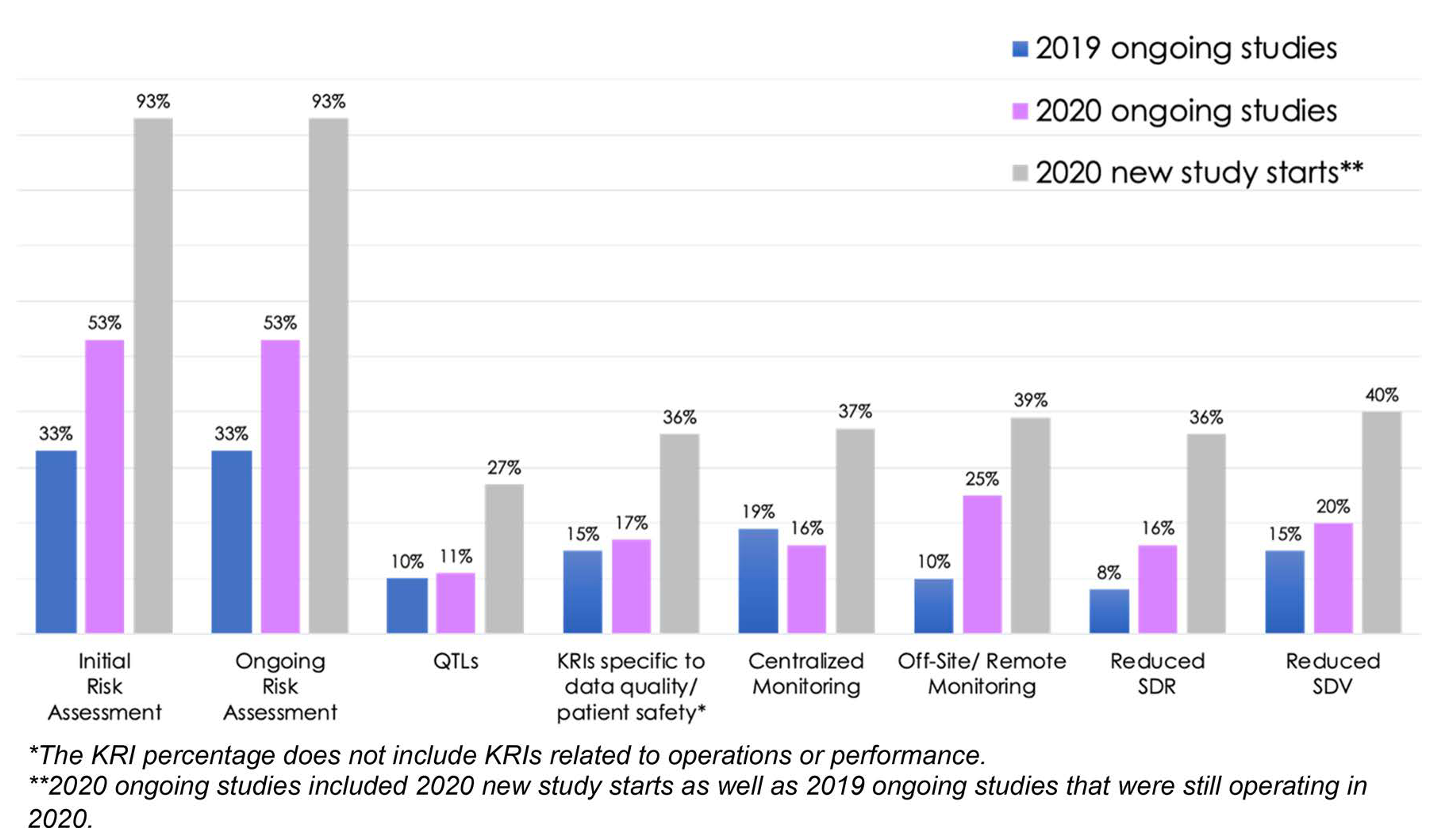Moving Beyond the Checkbox Approach With Risk-Based Quality Management
With risk-based quality management (RBQM), the industry is uniquely positioned to amend Murphy’s Law and propose something new—“Everything that can go wrong, we can work to identify and prevent.”

Sponsors and CROs can improve the quality of clinical trial data and increase efficiency with risk-based quality management (RBQM). Regulatory agencies encourage its use, but only a small percentage of companies have truly adopted a full RBQM strategy. A recent Association of Clinical Research Organization (ACRO) study found that although the percentages of trials incorporating reduced source data verification (SDV) and reduced source data review (SDR) increased from 2019 to 2020, the numbers are low considering the large percentage of trials implementing at least one RBQM component.1
Fewer trials relied on SDR and SDV from 2019 to 2020, but not at a rate that shows risk-based quality management is being applied broadly in the industry. (Source: ACRO)

A likely reason for this could be that it takes nearly six years for innovations supporting clinical execution to go from planning to broad adoption.2 Without an established RBQM strategy, many continue to rely on 100% SDV to ensure compliance. Even with the progress made in applying risk-based approaches, seven out of ten new job postings for clinical research associates (CRAs) still require travel, stating between a 65 to 80% travel requirement.3 This is surprising since SDV is one of the most time and cost-consuming areas in clinical trials, making up 25 to 30% of the total cost of a study.4
COVID-19 made monitoring even more challenging since companies hadn’t widely applied RBQM (only 22% of trials included at least one RBQM component),1 and most didn’t have mitigation plans for a global pandemic. Study teams had to refocus their limited resources on higher-risk areas to continue their clinical trials, highlighting the importance of conducting study risk assessments.
RBQM can prepare organizations for unforeseen disruptions while simplifying trial processes. Here are three key learnings from companies that have done this successfully and improved their risk-based approach.
Letting go of 100% SDV
Study teams are focused on maintaining compliance during a trial and often return to SDV to prove data accuracy. But even with 100% SDV, there is a 0.27% error rate,5 so the risk of non-compliance still exists. The manual line-by-line checklist mentality is counterintuitive to the core principles of risk-based approaches and minimizes their value. RBQM strategies should be part of the initial study design to optimize trial quality and efficiency.
Creating protocols with RBQM principles in mind can reduce unnecessary complexity and burden. Regulators realize there is a need for change, and the release of ICH E6 (R3) shows they are providing guidance for the industry that enables more flexibility in conducting trials. The guidance states that clinical trial designs and processes (like SDV) should be proportionate to the risks inherent in the trial and the importance of the data being collected.6
By lessening the reliance on crossing items off a list and following a risk-based approach, study teams can remain focused on enhancing remote activities while preserving data integrity and study quality. For example, evaluating study risks during the start-up phase enables clinical leaders to implement mitigations. If a threat occurs, companies will be in a position to take immediate action and enable future preventative measures.
Building a foundation for risk
Successful RBQM demands a deep understanding of critical data and processes, quality tolerance limits (QTL), and risk assessments and reviews. By identifying risks upfront, organizations can pinpoint the areas that need the most attention and shift the focus to quality, efficiency, and patient safety.
Once the most significant challenge areas are discovered, it’s best to create a working group of cross-functional resources with direct knowledge and valuable insights about the problem areas or desired outcomes.Establishing this strong risk management foundation will help companies learn their baseline risk level. The early planning will allow organizations to determine the riskiest areas and assign key resources to monitor and mitigate them. Technology can be an enabler to more streamlined and seamless RBQM processes.
ICH E6 (R3) encourages the use of technology, so identifying systems that make applying RBQM strategies easier should be a top priority. Sponsors and CROs must consider systems that embed risk assessment capabilities where the work, tracking, and mitigation or remediation actions are done—in a clinical trial management system (CTMS). This delivers complete, closed-loop issue management for greater efficiency and speed.
Putting change management on a pedestal
While COVID-19 increased risk awareness, the actual risk mentality throughout many organizations and teams has remained unchanged. Fortunately, clinical leaders are looking for new ways to implement preemptive measures that can ensure readiness and limit future business and clinical trial disruption.
The shift from 100% SDV to an RBQM strategy where reduced SDV is implemented will take education and preparation. Start with cross-functional buy-in, informing stakeholders on roles and responsibilities. Training sessions and open forums, led by the RBQM cross-functional working group, can help drive alignment and collaboration. The change in approach will also require coordination and cooperation with other functional areas, such as clinical data management, pharmacovigilance, and statistics.
Stakeholders across these areas have domain expertise to help create risk assessment templates, key risk indicators (KRIs), QTLs, monitoring plans, reporting, and other components within a comprehensive RBQM program. Other success factors include a commitment from leadership to drive organizational change, the ability to evaluate processes from a holistic view (not based on the company’s current structure), and baseline metrics.
Driving quality and speed with RBQM
The time has come for organizations to prioritize implementing a true RBQM framework. Clinical teams must move beyond the checkbox approach to maximize efficiency and productivity.
To get started, evaluate clinical trial technologies that make adopting RBQM easier. Look for tools that embed the risk assessment within a CTMS and provide risk templates for reuse across studies. Basic Excel trackers or point solutions could add complexity and don’t offer the same efficiency gains. As we enter a new era of more connected, digital clinical trials, it is a great time to explore RBQM and its potential to positively impact trial outcomes and patient health.
Lauren Garson, senior director, clinical strategy, Veeva Systems
References
- ACRO, Risk‑Based Monitoring in Clinical Trials: Increased Adoption Throughout 2020, 2022
- Tufts Center for the Study of Drug Development, Impact Report Volume 24, Number 4, 2022
- Indeed, Clinical Research Associate Openings, Last updated Aug. 2022
- American Pharmaceutical Review, Ways to Lower Costs of Clinical Trials and How CROs Help, 2016
- NIH, Impact of source data verification on data quality in clinical trials: an empirical post hoc analysis of three phase 3 randomized clinical trials, 2015
- ICH, ICH E6 (R3) Guideline for Good Clinical Practice (GCP), 2021